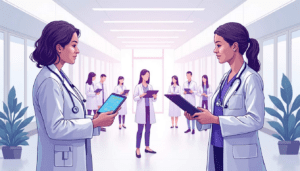Effective Live Chat in Patient Interactions
10 Jul 2018 By: Maria Rush
Updated
Live chat has transformed how patients communicate in healthcare settings, offering a direct and quick way to get support. This tool helps manage tough conversations by enabling healthcare professionals to respond swiftly and empathetically to concerns. By using live chat in patient interaction, providers can create a more supportive atmosphere that improves health outcomes and boosts patient satisfaction, ultimately leading to a more positive experience for everyone involved.

Understanding the Nature of Difficult Patient Interactions
Difficult patient interactions come in many forms. Healthcare professionals must spot and prepare for these tough situations to respond properly. Whether a patient shows frustration, anxiety, or demanding behavior, knowing how to communicate effectively can ease tension and lead to positive results.
In healthcare, managing tough patient interactions requires more than basic communication. It involves empathy, patience, and active listening. Healthcare workers must address not just the immediate issues but also the deeper reasons behind a patient’s challenging behavior.
Identifying Challenging Scenarios in Patient Communication
Patients often feel frustrated when they think their concerns are ignored. This can increase dissatisfaction. Some patients may also have unrealistic expectations or demand quick results. Healthcare professionals need to recognize and respond to these situations with empathy and clear information.
Additionally, patient interactions can be complicated by miscommunications, cultural differences, or language barriers. These factors require healthcare workers to adjust their communication methods to ensure they engage effectively and respectfully with all patients.
Psychological Factors Influencing Patient Behavior
Understanding the psychological factors affecting patient behavior helps manage tough interactions. Patients might show anxiety, fear, or anger due to their condition or past experiences. Recognizing and addressing these emotions can make patients feel understood, improving interactions.
Additionally, considering trauma, mental health issues, and coping strategies is crucial. By adopting a holistic approach, healthcare providers can customize their interactions to meet each patient’s needs, building trust and collaboration in the healthcare environment.
The Role of Live Chat in Patient Communication
Live chat is becoming a key tool in patient communication, offering easy access, convenience, and efficiency over traditional methods. Yet, its use in healthcare comes with challenges that must be managed for successful integration.
Instant communication through live chat boosts patient engagement and satisfaction. Patients can ask questions, get clarifications, and engage more actively in their care. This heightened involvement can improve health outcomes and treatment adherence.
Advantages of Live Chat in Healthcare
Live chat allows patients to communicate with healthcare professionals instantly, without being physically present. It’s especially useful for those with mobility issues or transportation difficulties. It also enables healthcare workers to handle several patient chats at once, boosting efficiency.
A major benefit of live chat is its ability to cut down wait times. Traditionally, patients might wait days for an appointment. Live chat offers quick answers, speeding up issue resolution and enhancing the overall patient experience.
Potential Challenges in Implementing Live Chat
Implementing live chat in healthcare has its challenges. Privacy and security are major concerns as patient information must be kept confidential and comply with regulations. Healthcare workers also need to adapt to showing empathy and building rapport digitally.
Another issue is the need for proper training and resources. Healthcare staff must learn both the technical use of live chat software and best practices for professional and empathetic communication online. Organizations must also invest in monitoring and managing live chat to maintain high-quality patient communication.
Strategies for Managing Difficult Interactions
Managing tough interactions needs strong communication skills. Active listening and empathy help ease tension and build trust. Setting clear boundaries and managing expectations also create a respectful environment for everyone involved.
In challenging situations, healthcare professionals should stay calm and think before responding to avoid misunderstandings. Approaching these interactions with a focus on the patient helps address issues effectively and promotes mutual respect.
Active Listening and Empathy in Live Chat
Active listening means fully focusing on the patient, showing you understand and validating their concerns. It pairs with empathy, which involves recognizing and acknowledging their feelings. By listening actively and responding empathetically, healthcare workers foster a supportive space that promotes open dialogue and trust.
Using reflective statements in live chat also helps show empathy and understanding. These statements rephrase the patient’s words, proving attention and deepening the connection. This approach is especially effective in digital settings, where non-verbal cues are absent.
Setting Boundaries in Digital Communication
Setting clear boundaries in live chat is key to keeping interactions professional and respectful. Healthcare professionals need to define their roles, responsibilities, and the limits of live chat. Clear expectations about response times and availability help manage patient expectations and prevent misunderstandings.
Also, a standardized protocol for discussing sensitive topics digitally ensures consistency and professionalism. Healthcare organizations should create guidelines on handling tough conversations and when to escalate care. With structured procedures, healthcare professionals can confidently and expertly manage difficult interactions.
Trending Now
An article from KevinMD.com talked about a challenging medical consultation. A physician skillfully manages a difficult interaction with a patient displaying narcissistic traits. A woman in her mid-fifties, dissatisfied with previous medical treatment and clinic procedures, dominates the conversation and questions the doctor’s expertise. Despite her demanding nature and skepticism, the doctor maintains professionalism, patiently explains medical assessments, and addresses her concerns clearly. The consultation ends positively, with the patient booking a follow-up, showcasing the significance of empathy, clear communication, and firm professional boundaries in managing tough patient interactions.
Training Healthcare Staff for Live Chat Interactions
Proper training is crucial for healthcare staff to effectively use live chat with patients. They need skills in clear writing and active listening to provide quality care and handle tough situations.
Staff must also know how to keep patient information confidential and follow HIPAA regulations. Understanding online data security and privacy builds trust with patients and ensures legal compliance.
Essential Skills for Effective Live Chat Communication
Effective live chat communication demands that healthcare professionals excel in written communication. Clear, concise messages with correct grammar and spelling are crucial for accurate information delivery. Even in digital settings, active listening is essential to understand and address patient concerns effectively.
Additionally, training in cultural competence is important. Healthcare staff must communicate respectfully and inclusively with patients from diverse backgrounds. Sensitivity to cultural differences enhances personalized care and fosters positive patient experiences.
Ongoing Training and Support for Staff
Continued training and support are crucial for healthcare staff to enhance their live chat skills. Opportunities for feedback and professional development keep them updated and improve patient interactions. Regular training and resources boost their confidence in providing quality care via live chat.
Including simulated scenarios and role-playing in training helps staff practice managing challenging situations in live chats. These exercises improve decision-making, empathy, and conflict resolution, enhancing care quality in digital communications.
Evaluating the Effectiveness of Live Chat in Patient Interactions
Measuring patient satisfaction and engagement is key to evaluating live chat’s effectiveness in healthcare. By collecting feedback and using data analytics, organizations can pinpoint improvement areas and optimize live chat services.
Live chat has transformed patient interactions, providing a convenient and efficient way to communicate. It enhances accessibility and responsiveness, offers real-time support, and allows for personalized care. This fosters stronger relationships and boosts overall satisfaction.
Measuring Patient Satisfaction and Engagement
Gathering feedback from patients about their live chat experiences offers crucial insights into its effectiveness. Regular surveys or feedback forms help assess satisfaction and pinpoint areas for improvement. Analyzing analytics data also helps understand engagement rates and identify potential issues.
Monitoring key performance indicators like response time, resolution rate, and customer feedback scores provides a comprehensive view of live chat’s impact on patient interactions. Tracking these metrics over time allows healthcare organizations to measure progress, spot trends, and strategize for continuous improvement.
Improving Live Chat Services Based on Feedback
Patient feedback should guide improvements in live chat services. Identifying recurring issues helps healthcare organizations tailor changes to enhance the patient experience. Efforts might include refining the live chat platform or additional staff training to ensure the tool remains valuable for managing patient interactions.
Integrating AI and chatbots can further boost live chat efficiency. These technologies automate routine tasks, offer instant answers to common questions, and triage inquiries. This allows human agents to focus on complex issues, providing a seamless and effective experience for patients.
Conclusion
Live chat has greatly transformed patient communication in healthcare, becoming essential in managing difficult interactions. By providing immediate and empathetic responses, it not only addresses patient concerns but also improves their overall experience. Live chat’s flexibility allows healthcare professionals to uphold professionalism and empathy in digital communications. As healthcare increasingly adopts digital solutions, integrating live chat offers a promising way to enhance patient satisfaction and health outcomes. Ultimately, effective use of live chat can change the dynamics of patient interactions, creating a more engaged and informed patient community.
“Empathy is a respectful understanding of what others are experiencing.”
— Marshall B. Rosenberg
Ready to transform your live chat service and manage difficult patient interactions with ease? Let HelpSquad BPO elevate your healthcare communication to the next level. Our skilled virtual assistants and 24/7 customer service team are available to support your needs at an affordable rate, starting at just $8.50 per hour. Experience the difference that professional, bilingual agents can make in your organization. Start your trial today and boost your efficiency with HelpSquad BPO!


